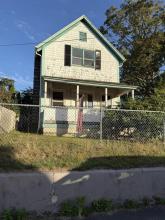State visits Agawam Village to evaluate handicap compliance
The State Department of Public Safety's Architectural Access Board recommended that the Wareham Housing Authority apply for variances and make minor changes to make public areas of the facility handicap accessible.
"I know that money is tight, but it's been going on too long," said the Henry Fernandes, a resident and former handicap inspector for the Town, who had complained to the housing authority about the issue in 2009. He received an invitation to the board's September 2009 meeting, but said that he wasn't allowed to speak. Dissatisfied, he complained to the state as well as the office of State Senator Marc Pacheco (D-Taunton).
Built in 1964, four years before the Americans with Disabilities Act required that all public buildings be accessible to handicapped persons, three areas at the state-owned, affordable-housing development were evaluated.
A temporary, steel ramp leading to the Housing Authority's office was found to be noncompliant for several reasons: the width between the handrails was incorrect, there was a hump in the center of the ramp, and the hinge-side of the door didn't have the necessary 18-inch clearance. . Also there was no permit for the installation and it was a temporary fix that was inappropriate for the building's use.
"Temporary ramps are for people who have had a short-term disability, or if you have to allow a handicapped person to access a stage for a special event, said Thomas Hopkins, executive director of the State's Architectural Access Board, who conducted the visit. "But a permanent housing-authority office should have something permanent and built in a permanent way. It moved with the weight of my wheelchair [Hopkins is handicapped] going over it."
A concrete ramp providing access to the community building was too narrow by an inch-and-a-half, and also had an incorrect slope.
Finally, the facility lacked a sign that labeled the handicapped parking space for visitors as van accessible.
Although formal recommendations will be made in their report of the visit, Executive Director Thomas Hopkins said that the fixes could be made with variances, a new ramp at the office, and new signage.
He expressed dismay, but not surprise when the Housing Authority told him that that the person who had sold them the ramp in 2000 had insisted it was fully compliant. Unfortunately, nobody had applied for a building permit, so that the noncompliance was not picked up by a building inspector.
He suggested that the housing authority apply for a variance for the ramp to the community building. He noted that the steel handrails were strong and that he could access the building and its bathrooms.
The handicapped-parking could be corrected by ordering the appropriate signage.
Hopkins said that he didn't know how much the estimated fixes would cost.
As a result of the visit, the state will cite the housing authority for the violations and issue a site report with recommended fixes. He offered his office's assistance in helping the housing authority submit applications for variances, and pledged to work with them on devising a satisfactory timeline for the repairs, particularly concerning the temporary ramp.
"To me these seemed like simple things to fix, or to allow variances for," Hopkins said. We didn't find slopes that were glaringly dangerous, and this is not an unusual process at all. I thought that the housing authority was extremely helpful and cooperative."
Housing Authority Executive Director Pam Sequiera said that she could not comment on the day, or the potential next steps, until after the housing authority's next meeting.
Fernandes said he was satisfied that they would replace the temporary ramp.
"I'm a trouble maker," he joked. "But today or tomorrow I might have to have a wheelchair...I live here and I have to protect myself if I get injured and help my neighbors."











